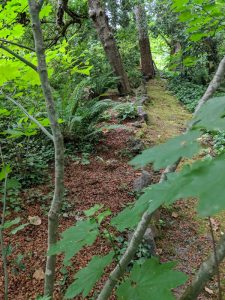Reusing Oregon Hazelnut Shells: Reducing waste, and saving the environment, with hazelnut shells
interview and photography by Vanessa Salvia
Turns out, Oregon’s hazelnuts are good for more than making pies, cookies and eating out of hand. Tualatin resident David Bantz, owner of He Sells These Shells, sells cracked, bagged hazelnut shells to garden centers and at farmers markets, and has participated in research looking into how effective hazelnut shells are at removing toxins from water. At home, Bantz has set aside a large area near his driveway where he unloads truckloads of hazelnut shells—80,000 pounds at a time. He bags them by hand and delivers them himself. Around his home, the hazelnut shells ll pots and line pathways, where this quintessential Oregon resource really shines. About 67,000 acres in Oregon are dedicated to growing the nut.
How did you get into selling hazelnut shells?
In 2008, I lost my job in land-use planning after the bottom fell out for land development. I found a couple part-time jobs in my field and didn’t like them, so I came home and told my wife, Sharie, that I was going to sell hazelnut shells! I had purchased some a number of years ago at a farmers market in Beaverton. I found a processor to buy directly from, and bought an antique weighing scale and started filling bags by hand. I’m selling to about twenty-five individual buyers that contact me directly, at the Milwaukie farmers market, a few hardware stores, the Backyard Bird Shop in West Linn and at thirty-three garden centers from Seattle to Cottage Grove. I also get about eight out of ten of my bags back for refills. I fill orders the same day or within two days. Sharie can get thirty 25-pound bags in her Kia Soul so she delivers for me when I can’t.
What are the benefits of using hazelnut shells rather than other mulches?
The nut processors don’t have any desire for the shells, so in the past those have ended up being burned or buried. So using them helps alleviate that. The cracked shells are pointy and rough, so slugs don’t like to crawl on them and cats don’t like to dig in them. They keep weeds from germinating because the shells are very dense, and in the sun they get really warm while also keeping the ground below them cooler, so weed seeds don’t germinate. The shells last for seven to eight seasons, while you have to replace bark mulch every year or two. They can be used to smoke meats and they add a nice flavor to barbecue. In fact, one of the uses I’m looking into is pelletizing them for wood stoves. You can pile the shells in the bottom of large pots to make them lighter and easier to move around.
Tell me about the water quality research into hazelnut shells.
The Port of Vancouver, a student at Cal Poly-Pomona and Georgia Tech have all used my shells for testing water quality. They’ve all found similar results. The Georgia study found that contaminated stormwater can be cleaned in the most effective way with nut shells in a burlap bag. The hazelnut filter removed more fecal coliform, hydrocarbons and heavy metals better than the $500 commercial filter.












We love reading your magazine. Our organization, the Oregon Retired teachers’ Association, has been rehabbing a small school on the Oregon State Fairgrounds. This one room school, the Criterion, was moved from Maupin, Oregon in 1976 to help celebrate the Bicentennial and celebrate education in Oregon and the importance it plays for our citizens. Each year we have 75 volunteer docents that guide a total of 3000 people through the Criterion School during the Oregon State Fair. We would love to have the Criterion School featured in 1895 Oregon magazine. Please let us know if this is possible.
Sincerely,
Sara Eck